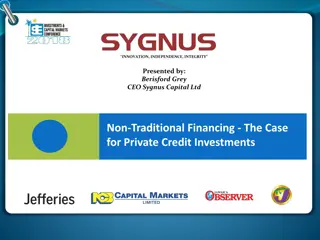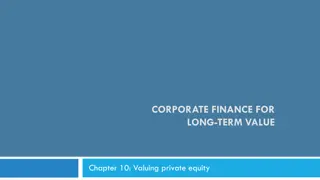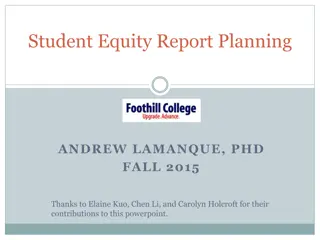
Understanding Private Equity Fund Terms and Exits
Explore private equity fund structures, terms, and exit strategies. Learn about GP/LP structures, distribution options, plan B exits, LP-led secondaries, and continuation funds in the private equity industry.
Download Presentation

Please find below an Image/Link to download the presentation.
The content on the website is provided AS IS for your information and personal use only. It may not be sold, licensed, or shared on other websites without obtaining consent from the author. If you encounter any issues during the download, it is possible that the publisher has removed the file from their server.
You are allowed to download the files provided on this website for personal or commercial use, subject to the condition that they are used lawfully. All files are the property of their respective owners.
The content on the website is provided AS IS for your information and personal use only. It may not be sold, licensed, or shared on other websites without obtaining consent from the author.
E N D
Presentation Transcript
Private Equity & Venture Capital Introductory Lecture 4 Fund Terms and Exits
GP/LP Structure of Private Equity
Private equity funds have a finite term of 10 to 12 years, and the money invested in them isn't available for subsequent withdrawals. The funds do typically start to distribute profits to their investors after several years. Summary Terms of Private Equity Fund Structure The average holding period for a private equity portfolio company was about 5.6 years in 2024. Several of the largest private equity firms are now publicly listed companies in the wake of the landmark initial public offering (IPO) by Blackstone Group Inc. (BX) in 2007. In addition to Blackstone, KKR & Co. Inc. (KKR), Carlyle Group Inc. (CG), and Apollo Global Management Inc. (APO) all have shares traded on U.S. exchanges. A few smaller private equity firms have also gone public via IPOs, primarily in Europe
GPs five options to generate distributions Selling minority equity position Selling outright Executing a fund-to-fund sale Dividend recapitalization IPO
LP Plan B Exits LP-led Secondaries Continuation vehicles (CVs) NAV Financing
LP Led Secondaries LP-led secondaries are transactions where a limited partner (LP) sells their interest in a private equity fund to a secondary buyer. The buyer then becomes the new LP in the fund, taking on the same rights and obligations as the original investor.
A continuation fund is a private equity vehicle designed to extend the holding period of one or more assets from an existing fund that has reached or is approaching the end of its lifecycle. The primary purpose of a continuation fund is to allow fund managers (general partners or GPs) to maintain control over promising assets while providing liquidity options to existing investors (limited partners or LPs) who may wish to exit. Continuation Fund Continuation funds emerged in the aftermath of the global financial crisis when many private equity funds found themselves holding assets longer than anticipated due to the challenging exit environment. The concept gained traction as both GPs and LPs recognized the potential benefits: GPs could continue to manage and add value to high-performing assets that needed more time to reach their full value potential, while LPs gained the optionality to either cash out or reinvest in the new vehicle.
Identification of assets: The GP identifies one or more assets from an existing fund that they believe have further value creation potential. Mechanics of continuation funds Structuring: A new vehicle, the continuation fund, is set up to purchase these assets from the existing fund. Pricing and valuation: An independent valuation is typically conducted to determine a fair price for the assets. LP options: Existing LPs are given the choice to: 1.Sell their pro-rata share of the assets and exit 2.Roll their interest into the new continuation fund 3.A combination of both New capital: The continuation fund raises capital from new investors, typically dedicated secondary funds, to purchase the assets and potentially provide follow-on capital to support the growth of the portfolio companies.
Mechanics of continuation funds Transaction closure: The assets are transferred to the new continuation fund, with proceeds distributed to selling LPs. Ongoing management: The GP continues to manage the assets in the new vehicle, typically with a reset of the fund s economics to better align the interests of the GP and LPs. For instance, carried interest is usually calculated from the current net asset value (NAV) at the time the continuation fund is established, not from the initial investment cost, thereby incentivizing the GP to generate returns above the new NAV.
Net Asset Value (NAV) is a term applied to companies, funds, partnerships, trusts or other investment entities that describes the current value of the entity, usually expressed on a per-share basis. In simple terms, the U.S. Securities and Exchange Commission defines Net Asset Value as a company s total assets minus its total liabilities . NAV Financing Funds will typically hold dozens, if not hundreds, of financial assets on behalf of their investors. A Net Asset Value calculation sums the value of all the assets, subtracts the value of any liabilities, and provides investors with a way to determine the value of their shares. For public funds (open-end investment companies), NAVs represent the exact price an investor can buy or sell shares, subject to any applicable sales charges or transaction fees. For closed-end fund entities, the price of a share is determined in the marketplace and may be above or below the calculated NAV.
PE Fund Valuation NAV Financing Since private equity shares do not trade on public exchanges, NAV is an important valuation measure for both the investors and the general partner. Investors can gauge how their investment is going from the progression of a fund s NAV over time. The NAV can essentially be interpreted as a measure of the residual value of investments held by the fund. Adding the NAV to any distributions already received from the fund will give investors a picture of how the total investment is progressing. General partners use the fund s NAV in determining the price for potential secondary transactions to third parties. Secondary transactions are important to general partners as a way of liquidating private company assets that have not gone public or been acquired in order to return capital to investors.
Carried interest is the performance or incentive fee in a private equity fund that is paid to the general partners. Carried Interest General partners are compensated for their operational role by a management fee, charged as a percentage of the fund s assets. They are compensated for their investment management role by a performance fee, charged as a percentage of the fund s profits above a certain amount. A typical fee arrangement for GPs is the 2 and 20 fee schedule, which pays the GP a 2% management fee on assets and 20% of the profits on the investments.
The performance fee gives the GP an incentive to maximize the returns to investors. That way the GP has skin in the game in the form of an interest in the fund s performance. This is accepted by fund investors as an assurance that the GPs interests are aligned with theirs. Since the ultimate profit in the overall fund will not be precisely known until all investments have been liquidated, the interest of the GP is carried throughout the fund s life. Carried Interest The GP s carried interest begins accruing as assets in the fund are sold. It is not usually paid out, however, until the investors receive their investments back plus a minimum expected return, known as the hurdle rate . Once the hurdle rate is achieved, the fund can begin paying the GP part of its performance fee in accordance with the rules set out in the investment agreement for the fund. Carried interest thus moves up and down as assets are sold and profits calculated but cannot be precisely determined until all assets have been liquidated.
The incentive arrangement, the hurdle rate, and the priority of payouts to the GP from investment proceeds are all detailed in the fund s investor agreement along with a distribution waterfall that outlines how the proceeds of asset sales are to be divided between the LPs and the GP. The waterfall schedule ensures that all proceeds from the fund s assets are directed either to the LPs or the GP in a manner that satisfies the investment agreement. (It should be noted that waterfall schedules may differ slightly between the US and Europe in their process but both have the same objective.) Hurtle Rates and Waterfalls Measures of fund valuation and performance, such as IRRs or MOICs are published net of carried interest.
A hurdle rate in private equity (also referred to as a preferred return or required rate of return ) is the minimum return that the fund must achieve for investors before the general partner ( GP ) or manager can share in the profits. Hurdle Rate (Preferred Return) In most private equity funds, the general partner is incentivized to achieve strong results for the investors by participating in the return as part of their fee. The hurdle rate ensures that investors get a minimum specified return before the general partner is allowed to participate. The GP must exceed the hurdle rate to share in the profits. Hurdle rates are cumulative and compounded annually. This means that returns to investors must exceed the hurdle rate for investment over its entire life before the GP can realize a share of the profits. The unrealized share of profits to the GP that may accumulate on an annual basis is referred to as carried interest or simply carry . Although unique to each fund, hurdle rates are usually measured using either the Internal Rate of Return (IRR) or a multiple of the initial investment. The details differ among funds and are described in the fund s offering documents. A hurdle rate of around 7-8% is typical of private equity agreements.
What is the soft and hard hurdle rate? Hurdle Rate (Preferred Return) There are two ways to share profits when a hurdle rate is exceeded. A soft hurdle rate allows the general partner to share in all returns this far, whereas a hard hurdle rate allows the general partner to begin sharing from the hurdle rate. As an example, assume a fund has an 8% hurdle rate and has achieved a 16% cumulative return. A soft hurdle rate would allow the general partner to share in the full 16% return, while a hard hurdle rate would allow the general partner to share only in the excess 8% over the hurdle rate.
Who sets the hurdle rate? Hurdle Rate (Preferred Return) General partners set the hurdle rate with their offering documents. Performance incentives are commonly built into private equity funds to align the general partner s interests with those of the investors. The hurdle rate defines the level of returns investors must receive before these performance incentives kick in, thus providing a benchmark return for the general partners to exceed while providing investors with a minimum preferred return before sharing it with the GP.
Distribution Waterfall A distribution waterfall in private equity is the methodology by which revenues and profits are split between the fund s investors and the general partner. The waterfall describes how much of the fund s distributions each party receives, what the priorities are between them, and how those priorities change as breakpoints or hurdle rates of return are achieved. The waterfall metaphor alludes to water pouring over buckets that subsequently fill up, allowing the remaining water flow to cascade into another bucket and so on. The metaphor is somewhat oversimplified since a private equity waterfall doesn t necessarily fill the investors or general partner s bucket completely before pouring into the next. Instead, there are limits to how much goes into each bucket, which change when certain overall parameters are met.
The need for describing how distributions will be split in a PE fund stems from the fact that private equity funds do not liquidate all at once. Instead, they generate distributions as underlying investments are sold. Since the proceeds of these sales come at irregular times and in varying amounts, and since both investors and general partners of the fund have a financial claim to them, it is necessary to stipulate exactly how these proceeds are to be allocated. The distribution waterfall outlines this process and is typically detailed in the fund s offering documents. Distribution Waterfall The waterfall structure also makes sure that the investors initially recoup their initial investments plus a predetermined rate of return (often called a "hurdle rate") before any profits are shared. This arrangement prioritizes investor capital protection and aligns the interests of the parties involved by incentivizing the general partners to maximize overall fund returns. This is because the general partners typically only receive their share of profits, known as carried interest, after the investors have received their initial investment and the hurdle rate is met. As a result, the waterfall structure is a critical tool to align the financial incentives between the investors and the general partners.
American vs. European Waterfalls Distribution Waterfall Distribution waterfalls tend to be structured differently between the U.S. and Europe, prompting the labelling of two types: European-style waterfalls and American-style waterfalls. European-style waterfalls (also called Global-style) give a higher priority to investors, requiring that investors receive all distributions from the fund until they have fully recovered their overall investment and achieved the hurdle rate in returns before the general partner can receive any portion of proceeds. This means that the GP will receive no incentive compensation, even while proceeds are initially coming into the fund. In contrast, an American-style distribution is applied to individual investment deals rather than to the fund as an aggregate. As long as the hurdle rate is met in each deal the GP can receive their share of the profits. This elevates the priority of the general partner such that they can begin participating earlier as a result of individual sales. At the end of a fund s life, the aggregate arrangement between investors and general partners must still be upheld. If later deals are not as successful as early ones, then a clawback feature is used to bring the GP s share back in line with the aggregate agreement.
How does a distribution waterfall work? Distribution Waterfall Distribution waterfalls will typically identify four tiers, which serve as the buckets into which cash will flow as investments are liquidated. The tiers are as follows: Return of Capital (ROC) This tier is the first into which cash will flow and 100% of it will normally go to the investors as their return of capital. Preferred Return Once the investors have received an amount equal to their initial investment, the next allotment goes to them as their preferred return or hurdle rate. This is essentially the minimum return that investors are entitled to receive before the GP can begin taking their share. Catch-Up Tranche Once the investors have achieved their preferred return, the GP receives 100% of the cash flow until they have achieved their specified participation percentage. Carried Interest/Residual Split When the hurdle rate is achieved, this is the portion of investment returns that will accrue to the general partner.
Multiple on Invested Capital (MOIC) IRRs and MOIC Multiple on Invested Capital ( MOIC ) is a metric used to describe the value or performance of an investment relative to its initial cost, commonly used within private markets. MOIC is among the most relevant metrics to be assessed while conducting fund due diligence. It is also often referred to as Equity Multiple. Internal Rate of Return (IRR) The internal rate of return, or IRR, is one of the main measures used by investors and finance professionals to assess the profitability of an investment. In mathematical terms, the IRR is the discount rate that makes the net present value (NPV) of all future cash flows equal zero in a discounted cash flow analysis (DCF).






















